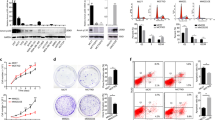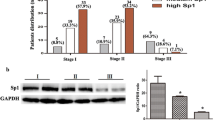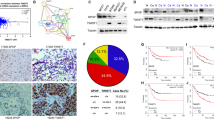Abstract
Aberrant scaffold attachment factor-B2 (SAFB2) expression is associated with several malignant tumors. In this study, we investigated how SAFB2 worked in the process of breast cancer as well as the underlying mechanism. Quantitative real-time polymerase chain reaction (qRT-PCR) and western blotting analysis were used to investigate the expression of SAFB2 and nuclear factor of activated T cells 5 (NFAT5). Cellular proliferative ability was detected with cell counting kit 8 (CCK8), colony formation and 5-Ethynyl-2′-deoxyuridine (EdU) staining assays. Cell apoptosis was measured via flow cytometry and western blotting analysis. Wound healing, transwell assays, and western blotting analysis were executed to estimate cell migration and invasion. The relationship between SAFB2 and NFAT5 was verified by RNA immunoprecipitation (RIP) assay and NFAT5 mRNA stability was examined with actinomycin (Act) D assay. Western blotting analysis also tested the expression of Wnt/β-catenin signaling-associated proteins. As a result, SAFB2 was downregulated in breast cancer cell lines, while NFAT5 was highly expressed in most breast cancer cell lines. Overexpression of SAFB2 suppressed the proliferation, migration, and invasion while exacerbated the apoptosis of breast cancer cells. SAFB2 interacted with NFAT5 mRNA and declined the stability of NFAT5 mRNA. Overexpression of NFAT5 counteracted anti-proliferative, anti-metastatic and pro-apoptotic effects of SAFB2 in breast cancer cells. Mechanistically, SAFB2 overexpression inhibited the Wnt/β-catenin signaling pathway, while this effect was partially eliminated by NFAT5. Collectively, SAFB2 hindered breast cancer development and inactivated Wnt/β-catenin signaling via regulation of NFAT5, suggesting that SAFB2 might be a promising therapeutic target for breast cancer.






Similar content being viewed by others
Data Availability
The datasets used and/or analyzed during the current study are available from the corresponding author on reasonable request.
References
Zhang, M., Bai, X., Zeng, X., et al. (2021). circRNA-miRNA-mRNA in breast cancer. Clinica Chimica Acta, 523, 120–130.
Sung, H., Ferlay, J., Siegel, R. L., et al. (2021). Global cancer statistics 2020: GLOBOCAN estimates of incidence and mortality worldwide for 36 cancers in 185 countries. CA: A Cancer Journal for Clinicians, 71(3), 209–249.
Nathanson, S. D., Detmar, M., Padera, T. P., et al. (2021). Mechanisms of breast cancer metastasis. Clinical & Experimental Metastasis, 39(1):117–137.
Norman, M., Rivers, C., Lee, Y. B., et al. (2016). The increasing diversity of functions attributed to the SAFB family of RNA-/DNA-binding proteins. The Biochemical Journal, 473(23), 4271–4288.
Townson, S. M., Dobrzycka, K. M., Lee, A. V., et al. (2003). SAFB2, a new scaffold attachment factor homolog and estrogen receptor corepressor. Journal of Biological Chemistry, 278(22), 20059–20068.
Hashimoto, T., Matsuda, K., & Kawata, M. (2012). Scaffold attachment factor B (SAFB)1 and SAFB2 cooperatively inhibit the intranuclear mobility and function of Erα. Journal of Cellular Biochemistry, 113(9), 3039–3050.
Hutter, K., Lohmüller, M., Jukic, A., et al. (2020). SAFB2 enables the processing of suboptimal stem-loop structures in clustered primary miRNA transcripts. Molecular Cell, 78(5), 876-889.e6.
Hammerich-Hille, S., Bardout, V. J., Hilsenbeck, S. G., et al. (2010). Low SAFB levels are associated with worse outcome in breast cancer patients. Breast Cancer Research and Treatment, 121(2), 503–509.
Dai, Z. T., Xiang, Y., Wang, Y., et al. (2021). Prognostic value of members of NFAT family for pan-cancer and a prediction model based on NFAT2 in bladder cancer. Aging (Albany NY), 13(10), 13876–13897.
Jauliac, S., López-Rodriguez, C., Shaw, L. M., et al. (2002). The role of NFAT transcription factors in integrin-mediated carcinoma invasion. Nature Cell Biology, 4(7), 540–544.
Küper, C., Beck, F. X., & Neuhofer, W. (2014). NFAT5-mediated expression of S100A4 contributes to proliferation and migration of renal carcinoma cells. Frontiers in Physiology, 5, 293.
Jiang, Y., He, R., Jiang, Y., et al. (2019). Transcription factor NFAT5 contributes to the glycolytic phenotype rewiring and pancreatic cancer progression via transcription of PGK1. Cell Death & Disease, 10(12), 948.
Amara, S., Alotaibi, D., & Tiriveedhi, V. (2016). NFAT5/STAT3 interaction mediates synergism of high salt with IL-17 towards induction of VEGF-A expression in breast cancer cells. Oncology Letters, 12(2), 933–943.
Lepland, A., Asciutto, E. K., Malfanti, A., et al. (2020). Targeting pro-tumoral macrophages in early primary and metastatic breast tumors with the CD206-Binding mUNO peptide. Molecular Pharmaceutics, 17(7), 2518–2531.
Yang, X., Song, H., Leslie, G., et al. (2020). Ovarian and breast cancer risks associated with pathogenic variants in RAD51C and RAD51D. Journal of the National Cancer Institute, 112(12), 1242–1250.
Oesterreich, S., Allredl, D. C., Mohsin, S. K., et al. (2001). High rates of loss of heterozygosity on chromosome 19p13 in human breast cancer. British Journal of Cancer, 84(4), 493–498.
Hammerich-Hille, S., Kaipparettu, B. A., Tsimelzon, A., et al. (2010). SAFB1 mediates repression of immune regulators and apoptotic genes in breast cancer cells. Journal of Biological Chemistry, 285(6), 3608–3616.
Kumar, A., Golani, A., & Kumar, L. D. (2020). EMT in breast cancer metastasis: An interplay of microRNAs, signaling pathways and circulating tumor cells. Front Biosci (Landmark Ed), 25(5), 979–1010.
Serrano-Gomez, S. J., Maziveyi, M., & Alahari, S. K. (2016). Regulation of epithelial-mesenchymal transition through epigenetic and post-translational modifications. Molecular Cancer, 15, 18.
Yeung, K. T., & Yang, J. (2017). Epithelial-mesenchymal transition in tumor metastasis. Molecular Oncology, 11(1), 28–39.
Remo, A., Simeone, I., Pancione, M., et al. (2015). Systems biology analysis reveals NFAT5 as a novel biomarker and master regulator of inflammatory breast cancer. Journal of Translational Medicine, 13, 138.
Najafi, S. M. A. (2020). The canonical Wnt signaling (Wnt/β-catenin pathway): A potential target for cancer prevention and therapy. Iranian Biomedical Journal, 24(5), 269–80.
Xu, X., Zhang, M., Xu, F., & Jiang, S. (2020). Wnt signaling in breast cancer: Biological mechanisms, challenges and opportunities. Molecular Cancer, 19(1), 165.
Acknowledgements
No applicable.
Funding
No funding support.
Author information
Authors and Affiliations
Contributions
HZ and HY made substantial contributions to the conception and design of the study. HZ, YY, and HY performed experiments, drafted and revised the manuscript for important intellectual content. HZ and HY confirm the authenticity of the raw data. All authors read and approved the final manuscript.
Corresponding author
Ethics declarations
Conflict of interest
There is no conflict of interest.
Additional information
Publisher's Note
Springer Nature remains neutral with regard to jurisdictional claims in published maps and institutional affiliations.
Rights and permissions
Springer Nature or its licensor (e.g. a society or other partner) holds exclusive rights to this article under a publishing agreement with the author(s) or other rightsholder(s); author self-archiving of the accepted manuscript version of this article is solely governed by the terms of such publishing agreement and applicable law.
About this article
Cite this article
Zhen, H., Yao, Y. & Yang, H. SAFB2 Inhibits the Progression of Breast Cancer by Suppressing the Wnt/β-Catenin Signaling Pathway via NFAT5. Mol Biotechnol 65, 1465–1475 (2023). https://doi.org/10.1007/s12033-022-00649-z
Received:
Accepted:
Published:
Issue Date:
DOI: https://doi.org/10.1007/s12033-022-00649-z




